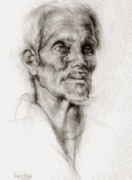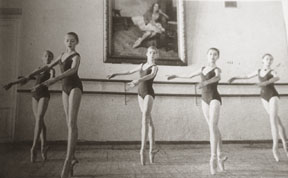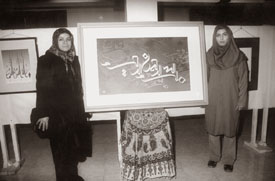|
DAILY NEWS ONLINE |
|
|
|
OTHER EDITIONS |
|
|
|
|
|
|
|
|
|
OTHER LINKS |
|
|
|
|
|
|
  |
|
Ranjith's Chitra Kala
|
|
|
'Chitra Kala' - a selection of oil paintings and charcoal drawings by Ranjith Perera will be held at the Lionel Wendt Art Gallery from October 28 to 30.
As a young student at Trinity College, Kandy Ranjith was inspired by the famous artist David Paynter who was restoring the murals of the College Chapel at that time.
While his friends played outside, 12-year-old Ranjith spent hours at the Chapel observing the great man at work.
From this early induction Ranjith developed a classical sense and a traditional old school approach to art experimenting with colour painting in oils and finishing life drawings in charcoal.
|
|
|
|
Ranjith, a graduate in Economics, Western History and Geography was busy and had a stressful executive career in the mercantile sector which did not afford him the time to acquire any formal instruction in art.
However, after his retirement again he plunged into his creative activities with 'brush and stroke' under the guidance of Nadine David, herself a student of David Paynter.
"I am motivated and inspired by simple themes depicting the Sri Lankan way of life, its people, the culture and the rich heritage of its past and the fauna and flora. Painting and drawing from life is my first love. Sri Lankan people and their past times fascinate me. The agony and ecstasy and simplicity reflected in their faces make marvellous subjects for my creations.
I draw inspiration from the richness of the colour that surround me - the birds, flowers, trees, and the fallen leaves provided a lifeline for my art," Ranjith says. Ranjith held his first solo exhibition displaying over 60 works in oil, water colours and charcoal at the Lionel Wendt Art Gallery in 2003.
The life of the class in ballet
|
|
The story of ballet is a perpetual fairy tale and an enduring fable that never ends. The reason for its enduring power is the temperament and spirit it gives the young dancer. The physical power and transcending limitations, the singleness of purpose are all gathered to cultivate this art. But all this has to be mastered in the class which unravels the creative process of the young dancers.
They all lead to the supreme eloquence of the dancer as she progresses. Yet, it is hard work, sheer dedication and the determination to reach the top.
The class is the structure that forms the dancer. It is a science devised in continuity by generation of ballet teachers, built upon the simple formula of relaxation and tension. It creates the human instrument for the expression of emotions in movement. It develops the dancer's personality, line and style. It guides her talent to accomplishment and keeps her tuned to the persuit of perfection. There is the test in the beginning; simple credentials; a genetic history that is compatible.
|
|
A supple physique, a musical sensibility and the gift of memory. These are the essentials; Learning such an art as ballet is a mystical process in which the heart and mind of the dancer is influenced, not only by the indoctrination and process of training or the love for a particular teacher and also by the innate talent and spiritual fervour.
Very lately, the early years of ballet training have been codified and also documented in precise terms. The daily routine is slow and careful and almost severe in the sparsity of dance movement that is permitted. The training is focused to a gentle, gradual, natural development, which with the unfolding of time and growth of the student, cultivates an aura of simple eloquence.
The disciplines and dynamic tensions the body is subjected to are never aggressive. The dancers grow up without strain and learn to wear their technical prowess as comfortably and unobtrusively as a favourite well-worn garment.
Basically there is always the joy in the work, an abundant freshness that lends exuberance to routine and makes every lesson special and pleasing. Every class is different. Yet, each class contains a unity of approach and application. Refinement and beauty are fashioned from toughened sinews. Strength is developed that attaint the superhuman. Only by exceptional effort results are obtained.
What are the secrets of techniques that distinguish each class from the other? They lie in the particular use of the traditional exercises devised by the old masters which is a balance between tension and relaxation used in every variety of rhythm by developing from small to large and powerful movements, called the syllabus.
Their Code read as:
1. Stance
2. Grand plies
3. Battements tendus
4. Battements jetes
5. Battements fondus
6. Battements frappes
7. Rond de jambes par terre/en L8air
8. Developpes
9. Grands Battements
10. Petits battements
11. Plies-releves.
Epaulement, a misunderstood term that means so very much. Perhaps this is the greatest secret of the class. The play of the shoulders and the head always falling in line with the body and the accomplishment that gives the longest line in every movement to manifest a natural facility to turn, to play the bodily instrument with fluent delicay is the result of Epaulement.
The accomplishment bred on the 'barre' is repeated in like order in the centre. The pattern is repeated unsupported while the practice continue, gathering momentum with growing orchestration of movement. This is the order of the day.... and every day Yet, each day, the class is created anew. Different combinations of steps, infinite variety of choreographic invention as limitless as the harmony of notes in musical composition.
Discipline has to be taught since it has to toughen sinews but this discipline leads to the greatest freedom and by its technique to the fullest expression.
These aspects conjure a perfection in movement are inadequate and be considered only as asignpost. The teacher's approach may be as variable as their personalities. Since the class is handed down from disciple to disciple there is no great discord in the syllabus taught.
The quality of the teaching only differs by personal preference and application and also by the innate talent of the teacher.
Thus the sequence movements and steps varies slightly with each individual teacher.
This is how classical ballet develop; the human architecture of anatomy that synchronize with the artistic evolution. Ballet in its finest mantle is really the summit of human discipline. It has long been the heart and soul of Russia, London, Paris, where the major companies have flourished and thereby extended to other major cities around the world. Their courage and sustanance became the symbol of their impregnable strength. It was also their unassailable beauty.
Creating art through script
Last week, two young Iranian artists had their exhibition of calligraphic art at Muslim Ladies' Study Circle Hall in Colombo.
|
|
I saw it as a fitting form of veneration to their God - Allah the Most Merciful and the Most Magnificent; the theme and the content of every piece of art was the calligraphic expression of the phrase "In the name of Allah the Most Merciful, Most Magnificent" in Persian script; and this is the holy month for Muslims - the month of Ramadan when every able Muslim observe fast and engage in piety between sunrise and sunset.
Syedeh Gogra Hossini and Taherah Heiat Esfahani, the two artists explained their work through an interpreter from the Iranian Embassy to eager onlookers, who were witnessing a new and rare form of art.
Syedeh and Taherah have studied calligraphy at the University of Tehran as part of their curriculum. Later, in their selected space of artistic freedom within the framework of their faith, they have been excessively innovative in producing some marvellous creations of art.
The phrase, "In the name of Allah the Most Merciful and the Most Magnificent" has taken different forms in each piece of art.
Some looked ornate pieces of gem-studded jewellery. Another large work reminded shadows on a still pool in a moonlit night, bringing a sense of inner calm to the beholder; another work resembled an artwork embossed on a piece of marble. In fact a careful onlooker would have seen how finely the marble has been chipped off to surface the script; smooth flowing script on the rough marble.
Script is the key to all human knowledge; Calligraphy if explained in the simplest way is beautiful handwriting; yet it has not been developed as an art form in our culture unlike in the East Asian region. With the advance of art and culture in these regions, their script too passed through an evolutionary process and gradually displayed signs of elegance.
This is very much true of the Arabic or Persian script, and the Islamic countries became the forerunners in the art of calligraphy. So, the Arabic world produced great masters of calligraphy who perfected it as an exclusive branch of art.
A number of calligraphic styles came into existence, each style being unique in its own way and was primarily designed for some specific purpose. The well-known styles of the Islamic script are: Kufi, Suls, Neskh, Taliq, Nastaliq and Shikastal.
Iranian artists have played an important role in deriving different styles from Islamic scripts. The Nastaliq style which has come to be recognised as the most elegant and beautiful all over the world today is known as the Persian script. This is commonly used in Afghanistan, Pakistan and India. Most of the books and magazines in these countries are written in this script.
Back to the creations of Syedeh and Taherah; they closely resemble an abstract genre of modern art. Through a very limited space of a selected few letters they have explored their power of creativity, which is guarded and disciplined by their faith.
|
|







